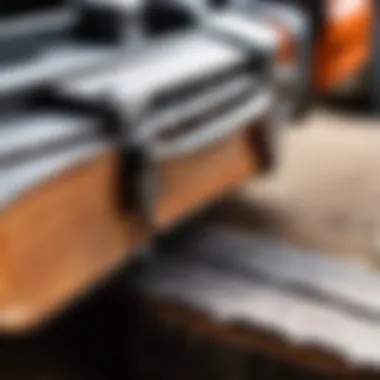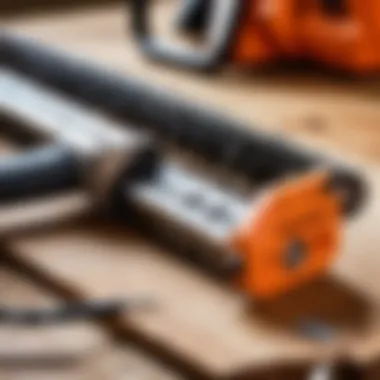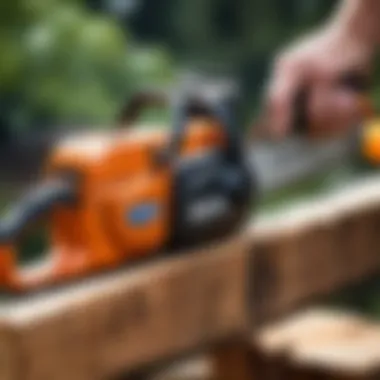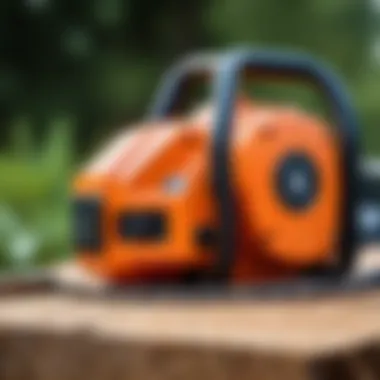Mastering Chainsaw Chain Sharpening with a File


Intro
Sharpening a chainsaw chain is a crucial maintenance step that enhances cutting performance and prolongs the tool's life. A properly sharpened chain not only cuts through wood with ease but also reduces the chances of accidents during operation. This guide details how to carry out the sharpening process using a file, ensuring effective results. Whether you are a novice or have experience, this article aims to provide step-by-step instructions tailored for DIY enthusiasts.
Проектирование и планирование
Как выбрать проект для DIY
When considering how to sharpen your chainsaw chain, planning is key. Before you begin, determine the specific needs of your chainsaw. Identify the type of chain you are working with, as different chains might require different approaches or tools. Familiarize yourself with the manufacturer’s specifications regarding sharpness and angle for optimal performance. A well-planned project can save time and ensure safe operation.
Оценка времени и ресурсов
Sharpening a chainsaw chain can take anywhere from 15 to 30 minutes, depending on the condition of the chain and your familiarity with the process. Evaluate the tools required for sharpening. At minimum, you will need a round file appropriate for the chain size and a file guide for precision. Ensure you have a sturdy work surface and safety equipment, like gloves and goggles. Having all tools prepared before starting will streamline the process and enhance safety.
Выбор материалов
Типы материалов для различных проектов
For sharpening the chain, the primary material you need is a round file. Files come in various diameters. Ensure to choose one that matches your chain's specifications. In addition to the round file, a flat file may be useful for maintaining the depth gauges, which are critical for safety. If your chain is substantially dull or damaged, replacement might be a better option than sharpening.
Советы по покупке и экономии
When purchasing files, consider quality over price. Brands like Oregon and Husqvarna are known for durability and performance. Look for sales or discount sections at hardware stores or online platforms to save costs. Purchasing in bulk can also be beneficial if you perform regular maintenance on multiple chainsaws.
"A well-maintained chainsaw not only performs better but also lasts longer."
By taking the time to choose appropriate tools and planning your project accordingly, you set the stage for successful sharpening. With these preparations in mind, you can proceed to the actual sharpening process with confidence.
Preamble to Chainsaw Maintenance
Maintaining a chainsaw is crucial for its performance, longevity, and safety. Regular maintenance can save users time and money in the long run. This article will explore the nuances of chainsaw maintenance, with a particular focus on how proper sharpening of the chainsaw chain can optimize cutting efficiency.
Importance of Regular Sharpening
Regular sharpening of the chainsaw chain is one of the most important aspects of chainsaw maintenance. A sharp chain cuts through wood more easily, reducing the strain on the engine. This not only enhances performance but also extends the lifespan of the tool. Sharpening should be done frequently, depending on the intensity of use. As chainsaw users, acknowledging the need for sharpening can transform the tool's productivity. Ignoring this detail can lead to unnecessary fatigue on the user's part as well as inefficient cutting.
Impacts of a Dull Chain
Operating a chainsaw with a dull chain brings several issues. First, it greatly increases the effort required to make cuts. Such inefficiency can be frustrating and tiring. Second, a dull chain is more prone to causing kickback, a dangerous situation where the chainsaw unexpectedly jerks upward, possibly leading to injuries. Third, using a dull chain results in additional wear and tear on the chainsaw, which can escalate maintenance costs and reduce the tool's lifespan. Therefore, understanding the importance of a sharp chain is essential for any chainsaw user, be they professionals or DIY enthusiasts.
Required Tools for Sharpening
The task of sharpening a chainsaw chain requires specific tools to ensure precision and efficiency. Understanding these tools allows users to achieve optimal results while minimizing risks associated with improper sharpening techniques. Each tool serves a unique purpose in the sharpening process. Selecting the right tools not only enhances the performance of the chainsaw but also extends its lifespan. Thus, having a clear grasp of the tools is essential for any individual looking to maintain their chainsaw effectively.
Choosing the Right File
Using the appropriate file is critical when sharpening a chainsaw chain. A file that's too coarse can damage the chain, while one that's too fine may not sharpen effectively. There are various types available, each with distinct applications.
Types of Files
Files come in different types, including round files and flat files. Round files are usually the choice for sharpening the cutter links of a chainsaw chain. This type provides a smooth surface and is designed to match the curvature of the cutter link. Its ability to remove metal effectively while maintaining the original shape of the cutter makes it a beneficial tool for this process. However, the disadvantage of round files can be their tendency to wear out quickly if used on hard or abrasive materials. Choosing the right type of file is fundamental for achieving a sharp, efficient chain.
File Sizes and Shapes
The sizes and shapes of files significantly influence their effectiveness. Files come in various diameters, typically ranging from 3/16 inches to 7/32 inches for chainsaw chains. The right size file should correspond with the pitch of the chain, which provides a perfect fit for sharpening. A smaller file may not adequately sharpen larger cutters, which can lead to inefficiency. One unique aspect of using different shapes, such as triangular or square files, is their specific use in sharpening depth gauges or for precision adjustments, thus expanding their utility. However, they can be less versatile when compared with round files, making them a choice for advanced users only.
Additional Tools Needed


Besides files, other tools are essential for effective sharpening. These tools not only simplify the process but also ensure safer handling and better outcomes.
Filing Guide
A filing guide helps maintain the correct angle during the sharpening process. This guide attaches to the chainsaw and provides a consistent angle, typically between 25 to 35 degrees, which is crucial for proper sharpening. With a filing guide, users can achieve uniformity in their cuts, reducing the risk of accidental damage to the chain. Moreover, its design allows for easy positioning, making it user-friendly. The downside is that it may require some initial adjustments before first use, depending on the specific chainsaw model.
Depth Gauge
The depth gauge is another important tool. It measures the height of the depth gauges in relation to the cutter links, ensuring they do not interfere with cutting efficiency. Properly adjusting these gauges helps maintain consistent cutting depth and enhances the performance of the chainsaw. While some might overlook it, a depth gauge can prevent problems like binding or stalling during operation. The downside of neglecting the depth gauge is significant; an uncalibrated depth can lead to uneven cuts and increased wear on the chain.
Preparation Before Sharpening
Preparation is a crucial step in sharpening a chainsaw chain. It ensures that the process is safe and effective. Proper preparation allows for a smoother workflow while minimizing the risk of accidents. Without preparing adequately, the results may be unsatisfactory, resulting in a poorly sharpened chain that does not perform well.
Safety Precautions
Protective Gear
Protective gear is essential when sharpening a chainsaw chain. It helps safeguard against potential injuries. The primary characteristics of protective gear include durability and functionality. Common items include gloves, safety glasses, and hearing protection. Such gear serves to reduce the risk of cuts and injuries that can occur during the sharpening process.
Wearing gloves provides grip and prevents direct contact with sharp edges. Safety glasses protect the eyes from metal filings or debris that may fly during sharpening. Hearing protection is often overlooked, yet, it is beneficial when working with noisy machinery. Investing in high-quality gear can greatly enhance safety while performing maintenance on chainsaw equipment.
Work Area Setup
The setup of your work area is equally important. A clean and organized space promotes efficiency. It helps reduce distractions and the chances of injuries. A significant characteristic of a proper work area setup is accessibility. Ensure that all tools needed for sharpening are within reach. This minimizes the need to move around or search for items while handling the chainsaw.
Additionally, having good lighting in the workspace aids in seeing imperfections or issues with the chain clearly. An uneven or cluttered surface may lead to accidents. Therefore, it is advisable to set up on a stable bench and to keep the area free of any unnecessary items.
Inspecting the Chainsaw
Checking Chain Tension
Checking chain tension is vital for several reasons. Proper chain tension ensures safe operation during cutting tasks. A chain that is too loose may derail, while one that is too tight can wear out components prematurely. When examining tension, a key aspect to look for is the ability to pull the chain slightly from the bar. If it pulls away easily, it likely needs tensioning. Maintaining the correct tension prolongs the life of both the chain and the guide bar, making this a necessary step in the maintenance process.
Identifying Damaged Links
Identifying damaged links can prevent further issues down the line. Inspecting the chain for sharpness is not enough. Key characteristics to look for include broken or bent links. A damaged link can lead to uneven cutting or even chain failure. An advantage of early detection is that you can often replace a link rather than needing to buy an entirely new chain. Examining each link regularly helps ensure the chainsaw functions properly, making it important to include in preparation before sharpening.
Understanding the Chain Structure
Understanding the chain structure of a chainsaw is essential for effective sharpening and maintenance. The chainsaw chain consists of several components, each playing a vital role in the performance and efficiency of the cutting process. Knowing these components allows the user to sharpen the chain with precision and to recognize issues that may arise during operation. This understanding directly affects the chain's cutting ability, durability, and safety when using the chainsaw.
A chainsaw chain primarily includes the cutter links and drive links. Each of these components contributes uniquely to how the chain operates. By understanding their roles, users can refine their sharpening technique, ensuring the chain cuts cleanly and reduces wear over time. Additionally, angle measurements are crucial, as they influence the cutting performance. Two critical angles should be considered: the hook angle and rake angle. Both angles need to be understood to optimize the chain's efficiency.
Components of a Chainsaw Chain
Cutter Links
Cutter links are the parts of the chain that actually do the cutting. They are designed with sharp edges that slice through wood. The key characteristic of cutter links is their sawtooth structure, which gives them cutting ability. This unique feature allows them to engage with the wood effectively, breaking it down with each pull of the chain.
Cutter links are often made from hardened steel, enhancing their durability. However, their sharpness diminishes over time and requires regular sharpening to maintain cutting efficiency. One of the advantages of cutter links is that they come in various designs, suitable for different cutting needs, such as ripping or cross-cutting. Properly maintaining cutter links is crucial to achieving optimal performance in chainsaw operation.
Drive Links
Drive links are critical as they transfer power from the chainsaw motor to the cutter links. The primary function of drive links is to ride in the chainsaw bar groove, guiding the chain around the bar while also providing strength. The key characteristic of drive links is their robust construction, capable of withstanding high stress while maintaining functionality. They are essential for ensuring that the chain moves freely and does not derail during use.
Drive links have a significant advantage in their ability to support cutter links and maintain tension. A proper configuration of drive links helps ensure smooth operation. However, these links also require inspection, as bending or damage can lead to inefficient cutting or safety hazards. Regular checks can prevent issues that might arise from worn or defective drive links.


Angle Measurements
Understanding angle measurements is crucial when sharpening a chainsaw chain. The angles affect how effectively the chain cuts into the material. Key angles, such as hook angle and rake angle, guide the sharpening process.
Hook Angle
The hook angle refers to the angle formed between the cutting edge of the cutter link and the vertical plane of the chain. This angle is important because it determines the amount of wood the cutter link will bite into during operation. A well-maintained hook angle enhances cutting efficiency. A typical hook angle is between 25 and 35 degrees, allowing for aggressive cuts without causing excessive drag.
An advantage of adjusting the hook angle to the correct specification is that it can improve the chain's cutting performance. However, if the angle is too steep, it may result in grabbing or stalling, which can be dangerous. Therefore, maintaining the correct hook angle is critical for safe and efficient chainsaw operation.
Rake Angle
The rake angle is the angle between the leading edge of the cutter and a horizontal plane. This angle influences how easily the cutter enters the wood. It essentially controls the amount of material removed during cutting. The typical rake angle is around 0 to 10 degrees, depending on the desired cutting action.
The unique feature of the rake angle is that it helps in reducing drag. A properly set rake angle prevents the cutter from bogging down in the wood, allowing for smoother cuts. However, an incorrect rake angle can lead to a dull cutting edge and inefficient performance. Therefore, understanding and maintaining the correct rake angle is essential in ensuring a chainsaw chain operates at its best.
Step-by-Step Sharpening Process
Properly sharpening a chainsaw chain is essential for maintaining optimal performance. This process can make a considerable difference in cutting efficiency and safety. In this section, we explore the step-by-step procedure that includes positioning the chain correctly, sharpening both left-hand and right-hand cutters, and understanding the importance of angles and strokes used in sharpening. Through this meticulous process, users can significantly improve the lifespan and effectiveness of their chainsaw.
Positioning the Chain
Clamping Methods
Clamping methods provide stability to the chainsaw chain during the sharpening process. When the chain is securely clamped, it prevents any unwanted movement. This is crucial for avoiding mistakes that may happen if the chain shifts while filing. One effective method is to use a bench-mounted chain vise. This tool allows for a firm grip on the chain, making it easier to maintain an even stroke while sharpening. A key characteristic of this method is its ability to accommodate various chain sizes, which adds to its versatility. However, it can be cumbersome if you have limited workspace.
Aligning the Chain
Aligning the chain ensures that the cutting edge is positioned accurately for sharpening. It is essential to align the chain according to the manufacturer's specifications. This alignment influences the angle at which you will file the cutters. A vital feature of this step is that proper alignment guarantees uniform sharpening across all teeth. This aspect is beneficial because it leads to balanced cutting performance. On the downside, misalignment can lead to uneven wear and inconsistent cutting results.
Sharpening Left-Hand Cutters
File Angle
The file angle is an important factor specifically when sharpening left-hand cutters. Typically, the prescribed angle ranges from 25 to 35 degrees, depending on the chain type. Maintaining this angle accurately contributes to effective cutting performance. A dominant characteristic is that it accommodates the unique geometry of left-hand cutters, allowing for efficient results. Neglecting the correct file angle can result in reduced cutting ability and increased resistance while cutting.
Stroke Technique
Stroke technique refers to how the file is used to sharpen the chain. For left-hand cutters, the recommended technique is to place the file against the cutter and apply a smooth, consistent stroke away from the body. This action ensures that material is removed evenly from the cutting edge. The appeal of this technique is its simplicity and effectiveness. However, inconsistent pressure or uneven strokes can lead to suboptimal results, necessitating careful attention during the process.
Sharpening Right-Hand Cutters
File Angle
Like left-hand cutters, the file angle for right-hand cutters is also crucial to ensure optimal sharpening. The angle should generally be within the same range of 25 to 35 degrees. This consistency is important for uniform performance across the chain. A defining characteristic of the right-hand cutters is that this angle reflects the design that aids in cutting direction. Failing to maintain the correct angle can compromise the chain's cutting effectiveness.
Stroke Technique
The stroke technique for right-hand cutters mirrors that of the left-hand cutters, but with slight adjustments. Position the file to maintain the proper angle against the cutter and use a controlled stroke away from your body. The straightforward nature of this method makes it popular among users. Nevertheless, just as with left-hand cutters, any inconsistency in the technique may result in uneven sharpening. Thus, focus on being methodical during this part of the process.
Proper sharpening is critical. Attention to details in positioning, angles, and techniques can lead to a greatly improved chainsaw performance.
Post-Sharpening Maintenance
Post-sharpening maintenance is a crucial aspect of chainsaw upkeep. After sharpening your chainsaw chain, proper maintenance ensures its longevity and performance. Neglecting this phase can lead to diminished cutting efficiency and increased wear. An effective maintenance routine involves two main tasks: cleaning and lubrication.
Cleaning the Chain and Bar


Cleaning is the first step in post-sharpening maintenance. Removing dirt and resin from the chain and guide bar is essential.
Removing Debris
Removing debris is vital for maintaining the effectiveness of the chainsaw. The buildup of sawdust, sap, and other materials can hinder the chain's movement and cuts. A clean chain allows for smooth operation and prolongs its life. This aspect is beneficial as it prevents unnecessary wear and tear.
It's easy to overlook debris, leading to clogs that can affect performance. One crucial characteristic of this process is the attention to detail in cleaning the intricate parts of the chain. Use a brush or compressed air to clear out any buildup. Regular cleaning also helps you identify potential issues, such as damaged links or tension problems, early on.
Lubrication Tips
Lubrication is equally significant in post-sharpening maintenance. Proper lubrication reduces friction between the chain and the guide bar. It is key in ensuring smooth cuts and protecting against overheating. Effective lubrication also aids in preventing premature wear on both the chain and bar.
One must use the right oil. Chain oil is specially formulated to adhere to the chain without being flung off easily. This unique feature of chain oil ensures even distribution during operation, facilitating optimal performance over time. Make it a habit to check the oil level and refill as necessary, especially after intensive use.
Checking Chain Tension Again
After sharpening and maintenance, reviewing the chain tension is essential. A properly tensioned chain is crucial for safe and effective cutting. If the chain is too loose, it can come off during operation, leading to accidents. Conversely, if it is too tight, it can wear down the drive links and saw itself.
To check the tension, pull the chain away from the guide bar. It should move slightly but must not be easy to remove entirely. If adjustments are needed, consult the user manual for specific instructions on your chainsaw model. This routine check is important for both safety and efficiency.
By keeping these steps in mind, chainsaw owners can ensure that their equipment runs smoothly and lasts longer.
Common Mistakes to Avoid
When sharpening a chainsaw chain, many users encounter common pitfalls that can affect the performance of the tool. Understanding these mistakes is essential for maintaining the efficiency of your chainsaw and ensuring accurate cuts. This section outlines critical errors to avoid, providing insights into the impact of these mistakes and offering strategies to maintain optimal performance.
Over-Sharpening
Over-sharpening occurs when users file the teeth of the chainsaw chain excessively. This mistake may seem harmless, but it can lead to several problems. Firstly, it reduces the length of the cutter links more than necessary and compromises their integrity. As a result, the cutters quickly become dull again, leading to frequent sharpening sessions.
Another issue with over-sharpening is that it creates an uneven edge on the cutters. A properly sharpened chain should have a consistent angle across all teeth. When grit is removed too aggressively, it can result in uneven cuts, causing the chainsaw to vibrate excessively and making it harder to control.
Tips to avoid over-sharpening:
- Know the right angle: Familiarize yourself with the correct angles for your specific chain. Every chain type has its specifications.
- Count your strokes: For consistency, count the strokes used on each cutter. This approach helps ensure uniformity across all teeth.
- Use light pressure: File gently and avoid excessive force when sharpening. Light pressure will help you maintain the integrity of the cutters.
Neglecting Depth Gauges
Depth gauges, also known as rakers, play a crucial role in how a chainsaw functions. They control the depth at which the cutting tooth bites into the wood. Neglecting these gauges means that the performance of the chain can be compromised. When the depth gauges are not maintained, cutting depth can become too aggressive or ineffective. As a result, it can lead to difficulty in cutting and even cause kickback.
In many cases, users focus solely on sharpening the cutter links while ignoring the depth gauges. This oversight creates an imbalance in the cutting process.
Recommendations for maintaining depth gauges:
- Regular Checks: Consistently check depth gauges alongside sharpening the cutters. If they are too high, it may be necessary to file them down.
- Use a depth gauge tool: Employ a depth gauge tool to set the appropriate height. This will ensure that all gauges are accurately trimmed.
- Maintain balance: Always sharpen depth gauges after every second or third sharpening of the cutters to ensure they remain at the proper height.
Final Thought: Addressing these common mistakes will lead to a better-maintained chainsaw chain, extending the life of your equipment while ensuring efficient cutting performance.
Epilogue
Recap of Key Points
Reflecting on the processes discussed, we outlined critical elements such as:
- Tools Needed: Selecting the right file and supplementary tools are essential steps in the sharpening process.
- Proper Techniques: Each step from positioning the chain to calibrating file angles has significant implications for the effectiveness of sharpening.
- Common Mistakes: Avoiding over-sharpening and ensuring the depth gauges are correctly maintained can greatly impact performance.
- Post-Sharpening Care: Cleaning and rechecking chain tension solidifies safer operation post maintenance.
Each of these points is a building block that fortifies the overall maintenance schedule for chainsaw users.
Encouragement for Regular Maintenance
Regular maintenance is not merely a suggestion but a necessity for anyone using a chainsaw. The benefits are numerous: enhanced cutting efficiency, reduced risk of injury, and increased durability of the equipment. Establishing a routine checking regimen fosters a proactive approach to equipment care. For instance, users should incorporate sharpening checks after every few hours of use, especially when engaging in more demanding cutting tasks.
To further drive this point, consider the correlation between a well-maintained chain and the quality of work produced. Maintaining standards in equipment performance ensures that tasks are completed effectively, saving both time and additional expenses in tools and repairs. As reflected in discussions throughout the article, investing time in sharpening and maintaining one’s chainsaw will yield dividends in efficiency and safety.







